The MikroTik CRS326-24S+2Q+RM is an insane switch. Its specs are relatively mundane by modern standards. It has 24x SFP+ 10GbE ports and 2x QSFP+ 40GbE ports making it not even as powerful as mainstream previous-generation switches like the QCT QuantaMesh T3048-LY8 that we installed in our lab years ago. Instead what makes the switch insane is that it offers all of that performance at $475. There are vendors still offering 24x 1GbE + 2x 10GbE switches at that price point. In our review, we are going to take a look at the switch and what it can do.
MikroTik CRS326-24S+2Q+RM Overview
The MikroTik CRS326-24S+2Q+RM has a very sane port layout. It is primarily a 24x SFP+ 10GbE switch. While we have looked at many smaller switches from the company all the way down to the MikroTik CRS305-1G-4S+IN 4-port 10GbE switch, this is a higher-port count switch from the company. For some context here, we have already been through generations of 48x 10GbE switches from traditional networking vendors, and now the market is focused on 24x 25GbE switches. Still, for MikroTik that targets more of the SMB sector, this is a relatively high port-count switch.
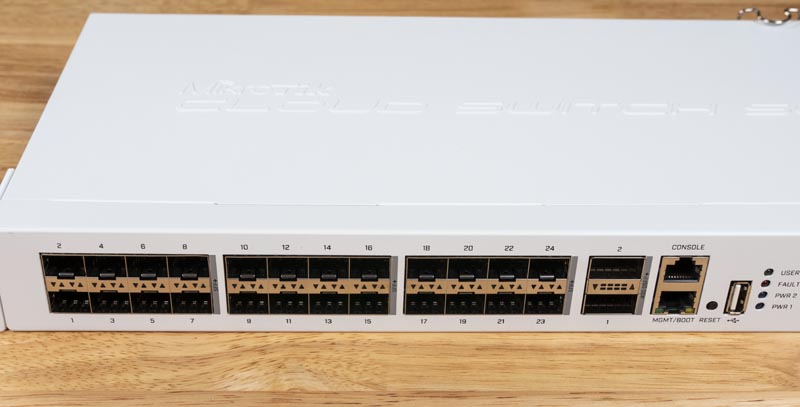
We have a video overview of the switch to accompany this review:
You may have seen that recently we looked at the MikroTik S+RJ10 SFP+ to 10Gbase-T modules. These modules allow the CRS326-24S+2Q+RM to address the needs not just of SFP+ networks, but also 2.5/5/10Gbase-T networking. MikroTik offers very reasonably priced SFP+ modules for their optics as well. The company is also very good at accepting optics from others. This is not a Cisco switch where only Cisco optics work.
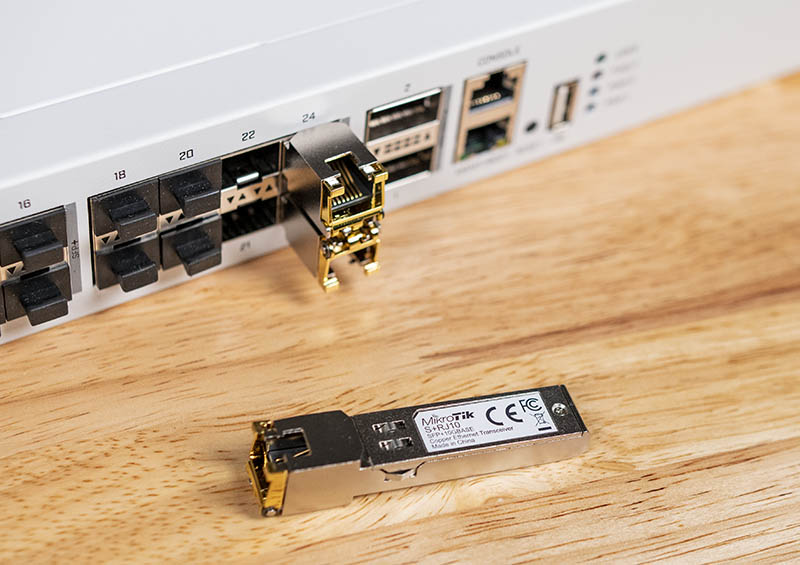
Where the switch goes into the realm of insanity is with the two QSFP+ 40GbE ports. This is huge for larger SMB networks. One can use these 40GbE ports to uplink to higher-end switches. Still, we see the most common use case is that they will be used to connect to higher-speed shared devices such as storage. Now, SMB IT can deploy 40GbE storage and use it with 10GbE servers easily. In extreme cases we can see this being used to provide connections for a faster server or workstation. Still, we think uplinks and storage are the two use cases. You will see in a screenshot later that these two 40GbE ports present themselves as 4x10G links as well and have four indicator lights each.
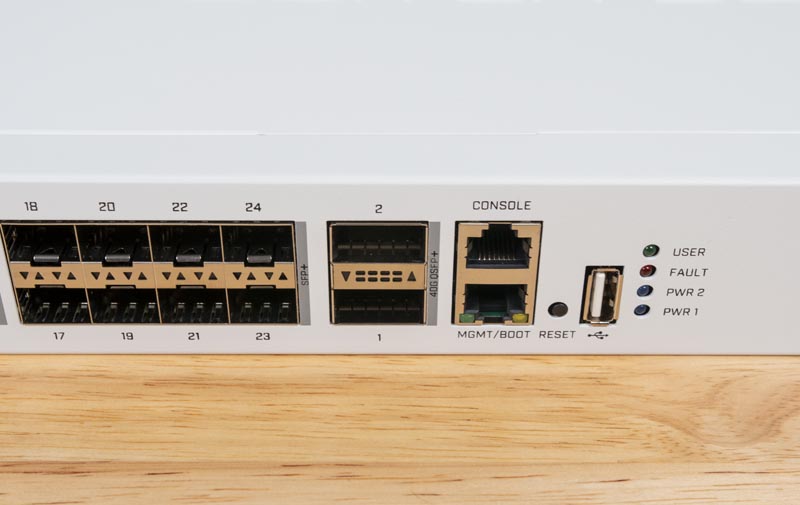
We really like that MikroTik has a NIC that one can use for out-of-band management. That is a feature found on higher-end switches and it is great that MikroTik is using it on their 10GbE line. Even the Dell X4012 12-port 10GbE switch did not have an OOB management port. One can also use a serial console port and there is a USB port as well.
At the back of the switch, we can find a simple to understand layout.
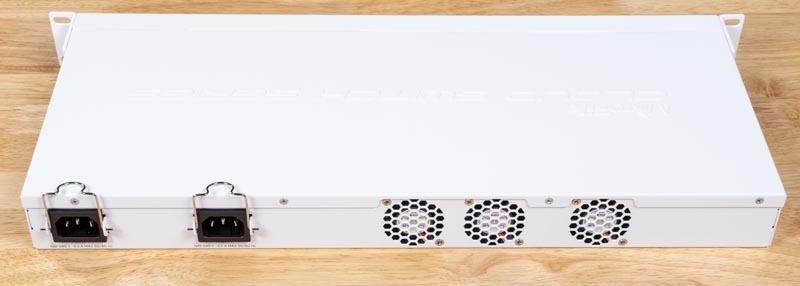
There are three 1U fans in the switch. These provide airflow since this switch uses more power than many of the company’s other 10GbE offerings.
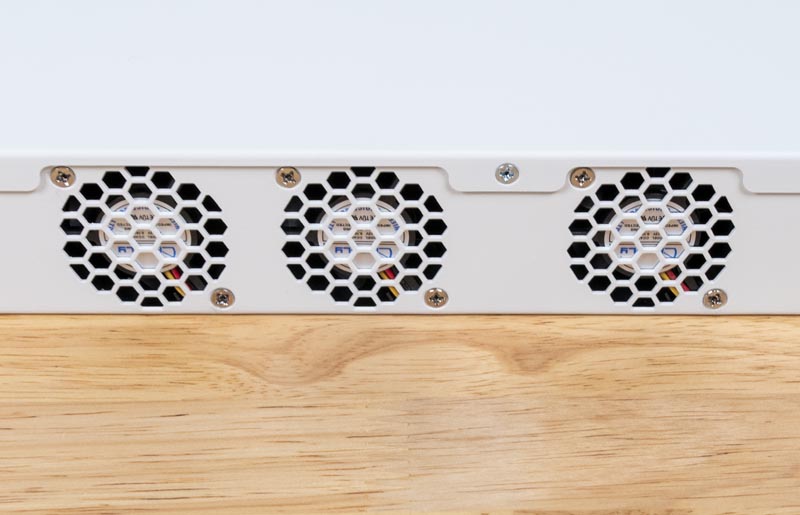
Power is provided by two power supplies that we will see sit internally later. That means there are two rear plugs. Each has a retention mechanism to prevent cables from being accidentally pulled.
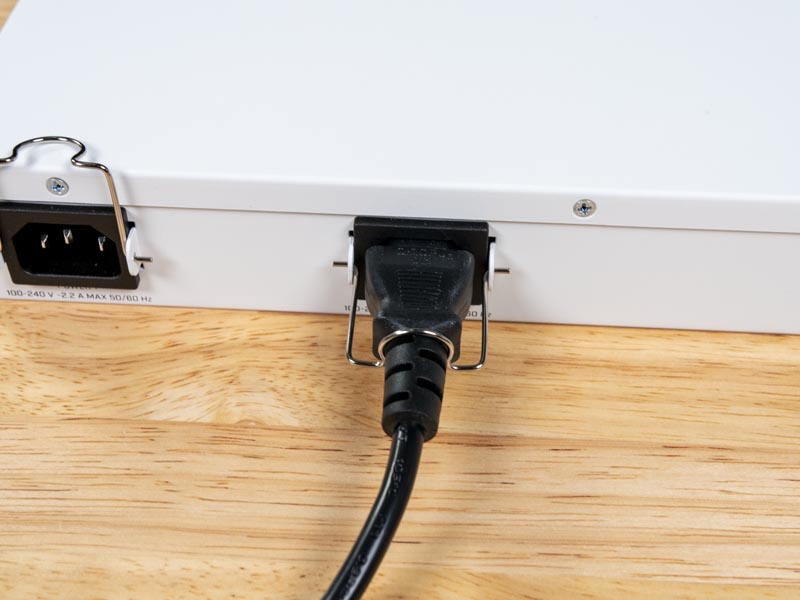
Inside the switch, we see a switch segmented into very distinct portions.
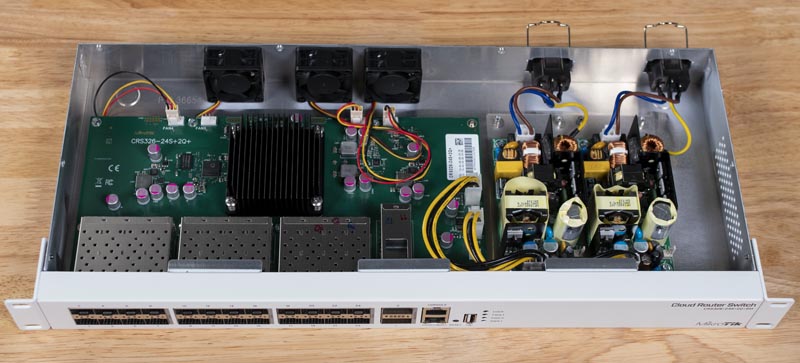
We wanted to point to the heatsink here which looks relatively mundane compared to the wild, and beautiful, heatsink we saw on the MikroTik CRS312-4C+8XG-RM. One can also see three sets of eight SFP+ cages which is fairly common in SFP+ switches.
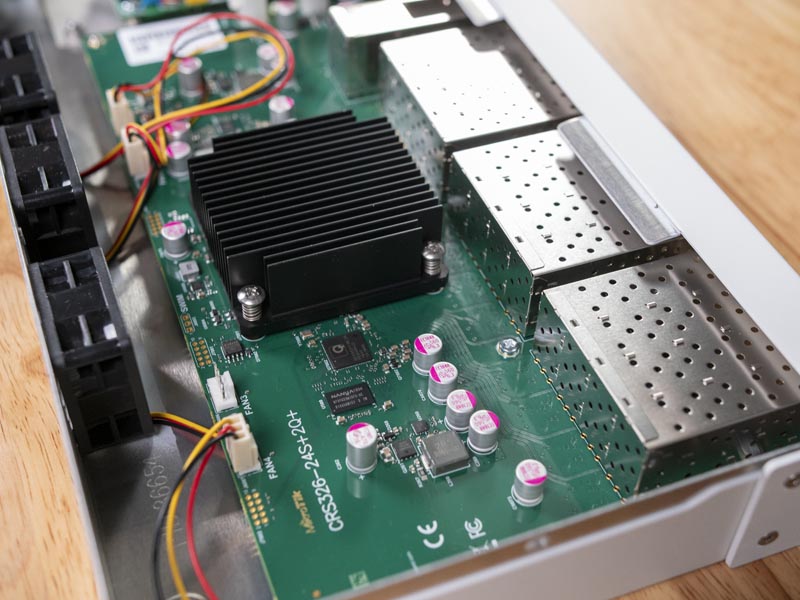
Cooling the heatsink, one can see three 3-pin fans. There is no ducting to focus airflow over the heatsink as we might see in a server such as in our Tyan Transport SX TS65A-B8036 review.
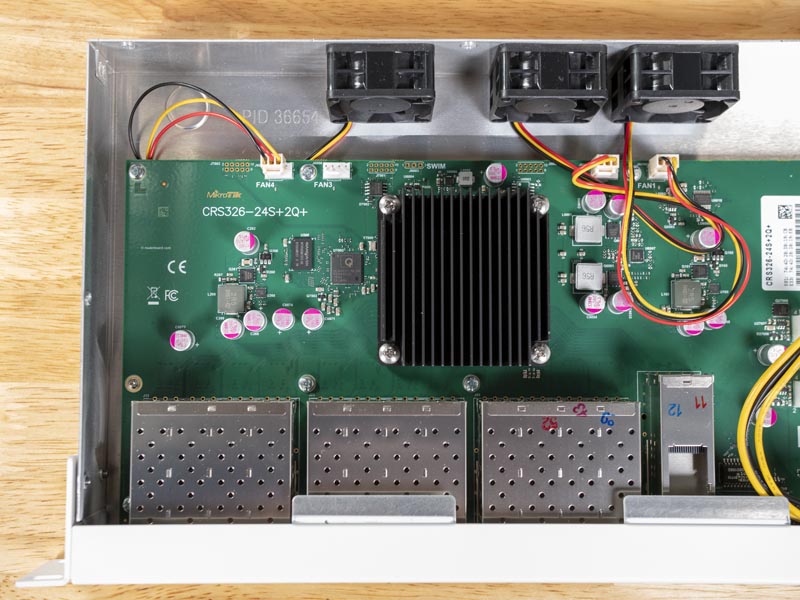
Some users on lower-end models have suggested swapping MikroTik’s fans for quieter models. We do not think that makes sense here even though there are four 4-pin fan headers.
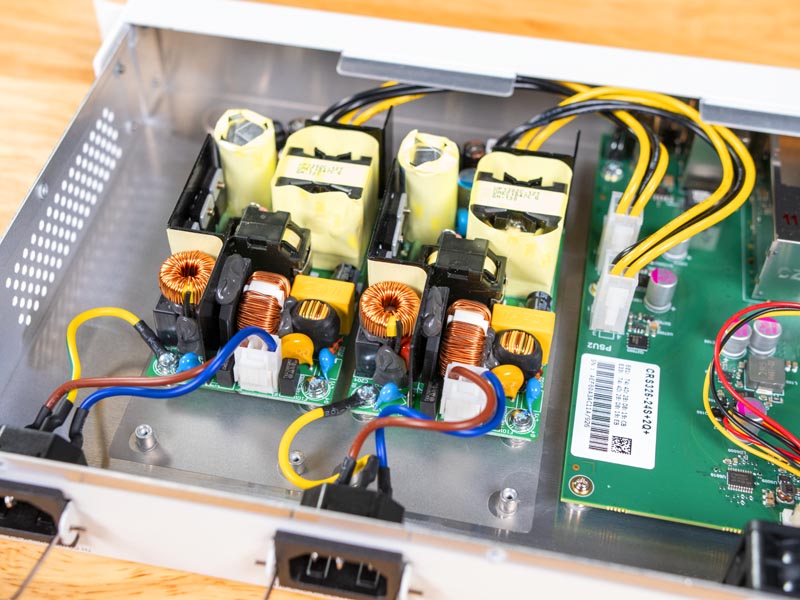
Inside there are also two power supplies. These units sit on distinct PCBs and are wired to the rear power input jacks as well as the motherboard. They look like they would be easy to replace, however, in practice this will rarely be done. Taking a switch out to service a power supply like this is rarely going to happen. Higher-end switches have redundant hot-swap power supplies. For this segment, having two PSUs we see as a bonus as we might expect one. Redundancy against power supply failures is good, but for many markets MikroTik services, utility power is not always constant so having a redundant power source at the edge, even if that is to a battery back up, is not uncommon.
MikroTik CRS326-24S+2Q+RM Software
By default this switch ships with RouterOS so it can be managed with WinBox, by the webfig, or via the shell.
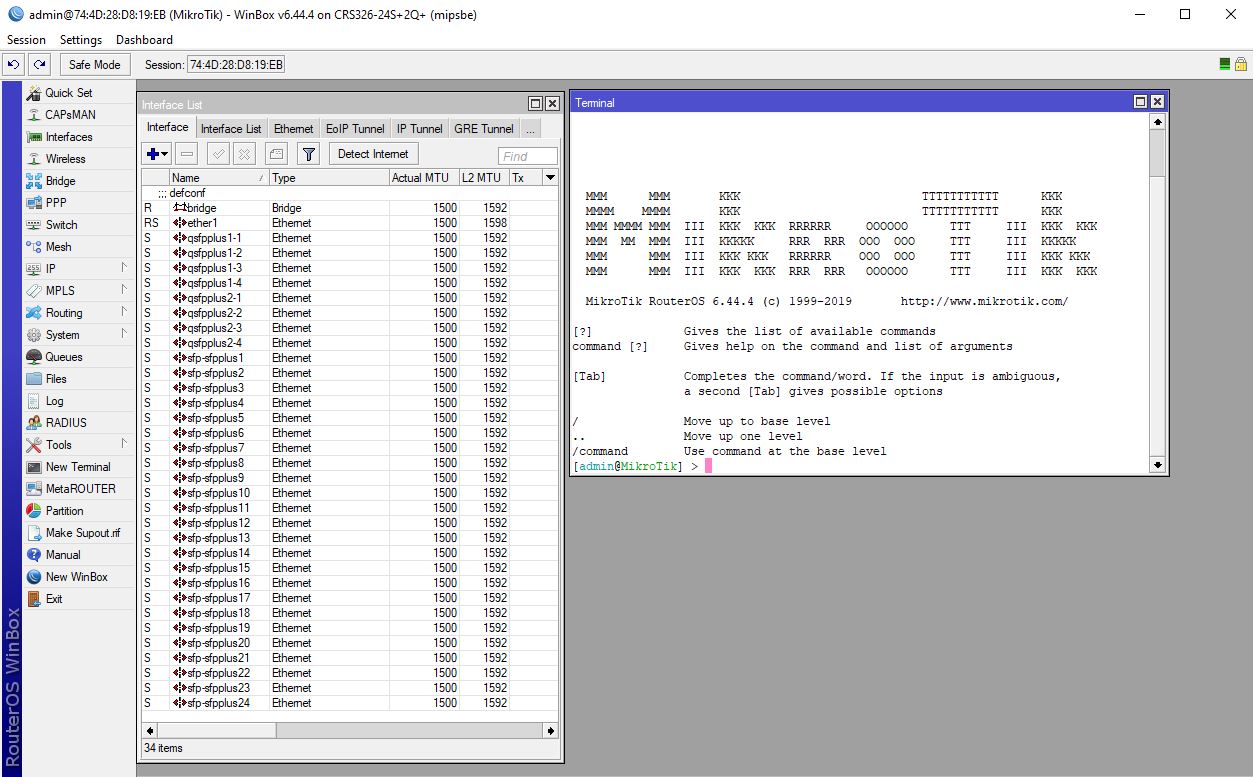
One can optionally install SwOS on this which is more focused on switching roles instead of providing the full routing suite.
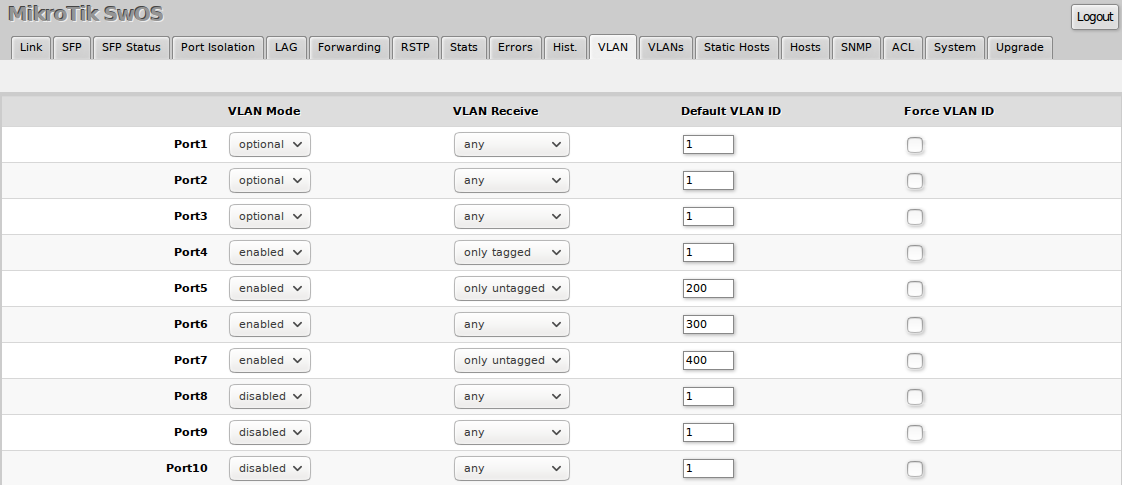
If you compare MikroTik’s software to that of many big vendors and their 10GbE offerings, MikroTik has a much more SMB IT-friendly setup with many GUIs. That means users who rarely change settings do not need to learn a CLI.
When to Use These Switches
We think that the MikroTik CRS326-24S+2Q+RM offers a truly unique value proposition. One can use a higher-cost 32-port data center switch and downlink to these in each rack to service 2U and 4U server installations. In the half cabinet colocation market, this provides connectivity for 1U servers as well as uplinks and QSFP+ 40GbE ports for storage servers.
For the edge, offices that need to connect multiple higher-speed devices can use this switch in an equipment closet and service high-speed workstation storage. A prime example of where this is just about the perfect device is for gaming cafes or lower-budget video editing studios.
Perhaps the more useful deployment in an office is to have this be a more central switch and use lower-cost SFP+ enabled switches MikroTik CRS312-4C+8XG-RM 12-Port 10GbE Switch Review or some of MikroTik’s 1GbE switches to change media types. The SFP+ links provide easy and inexpensive access to fiber networking. Also, using the MikroTik S+RJ10 one can convert select ports to 10Gbase-T or Nbase-T inexpensively.
At the same time, this is a $500 switch. It does not come with the same level of support one can get from Cisco, Arista, Juniper, HPE, Dell, and others. One can reasonably protect against hardware failures by having a hot or cold spare and a plan to service, but that needs to be added to the cost of owning this type of switch.
A Note on Performance
We typically use these for fairly simple networking either with flat networks or using some VLANs but without routing. Since our typical network usage is small file transfers when we are doing things like loading ISOs via IPMI or running management tasks. If you need highly specialized networking or the lowest latency switch, you probably are not looking at the $499 price bracket. For its intended use, it is fine. Here are the official switching results from MikroTik:
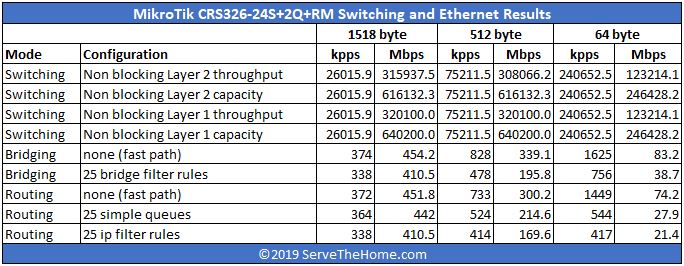
If you are using L2 features, the switch offers perfectly acceptable performance although small packet sizes can impact performance. Once more features are used, the 650MHz processor simply cannot keep up. The switch is not designed for this type of performance.
Power Consumption
We tested power consumption on 120V power since that is common at the edge where these will be deployed in North America. In terms of actual power consumption we saw:
- Idle Power: 14W
- Max Observed Power: 58W
- Max Power from Spec Sheet: 69W
One can get better power consumption figures using 208V or higher power. Still, this is considerably better than larger switches. That means operating costs are much lower.
A max 69W 1U short depth box is going to make noise. We had to run this in our data center lab to max connections but we did an initial power on in the office just to see. It was clearly too loud to have in a habitable area where people live and work. At the same time, the noise was at an acceptable level for an equipment closet, albeit we only had two QSFP+ and four SFP+ DACs plugged in at that time. Still, for those that think about doing a Noctua 40mm fan swap, we would caution that this is a significantly higher-performance and power consumption device than the lower-end switches and thus a lot more air needs to be moved through the chassis.
Final Words
MikroTik has something really innovative here. We like that the company is pushing to 40GbE networking, but we also wish the company was moving to 25GbE. SMB gear may still focus on 10GbE, but 25GbE is going to be very common in servers starting next year. We wish the power supplies had some hot-swap mechanism. We also wish there was some easy way to make this switch quieter.
In terms of market, if we think of an office or data center cabinet with a limited IT budget but that wanted to use SFP+ (or 10Gbase-T with the S+RJ10 adapters) then this is a very logical device.
What makes this switch utterly insane is that it sells for under $499. This puts the MikroTik CRS326-24S+2Q+RM at new pricing in competition with 48 port SFP+ used switches that have been decommissioned after 4-5 years. Just the fact that you can buy a switch new at this price point that is relatively energy-efficient and has this much capability borders on insane.

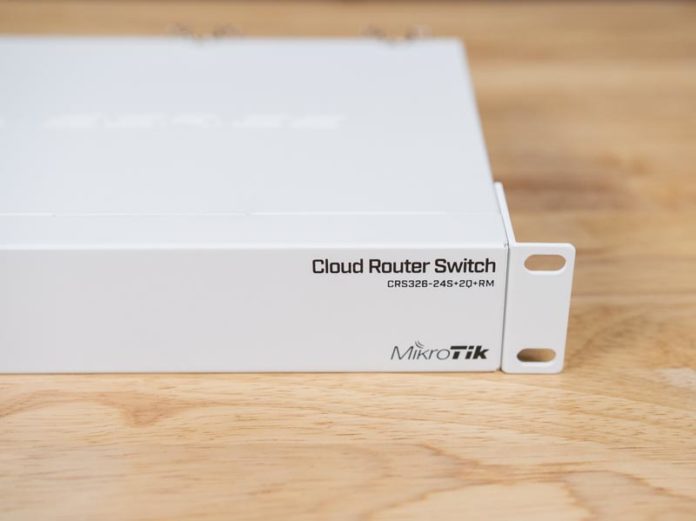



I like that MikroTik’s doing this. I don’t really see the need for a 24 port switch. If they did 8SFP+ and 6QSFP+ That’s almost more useful since that’s really different that what’s on the market. It’d let you have a small QSFP+ switch for workstations.
Only 24 ports is too small for a full cabinet of gear.
It’s nice that STH is reviewing these now. I like the video sidecar.
@ Jed This would work well for a SMB that has only 5 or less hosts, but wants to use vSAN. Each host would be able to connect with 4x 10GbE and still be connected to your routers and connections between switches. Also would work nice for a small DR site where you want to use vSAN to save on rack space.
If you could afford vSAN not sure you’d be using this class of switch but maybe I’m wrong. I love the energy efficiency. I have a hate relationship with the OS but that ain’t going to change soon and most people don’t seem put off by it.
Company I work for got into the VMware partner program before they changed it to the current model. VMware included perpetual vSAN licenses with all the other licenses we got from them. We do not use vSAN but have the licenses if we were to choose to use them.
After years of the vendor consortia milking the 10Gb market it is good to see a break in the stone wall. Good for Microtik, and good for STH for showing the product.
You can get these for $450 on Amazon. I love this company; they’re doing so much to democratize access to high-end networking.
Thank you very much for the review STH, always good quality content… This is the perfect switch to pair with my CCR1036-8G-2S+EM router and my Mellanox SX6036 switch.
What are the boot times of this little one with SwOS?
What’s the reason you don’t think a Noctua fan swap would cool this switch? There’s 4 pin headers, they should ramp (although I’m a little scared as they don’t ship with 4 pin fans)
MS – I think they’re saying it because those Noctua fans are quieter but are not designed to move the same air and static pressure as Mikrotik’s. Just because there’s a fan doesn’t mean it’s as effective.
Hi Jorge,
The entire Noctua range.. both static pressure and flow optimised models..?
mea culpa… I just checked the 40mm offering from Noctua.. I didn’t realise there wasn’t a lot of variety in that size. Sorry.
Still curious to hear from someone who’s tested it though.
Hello,
Would you recommend it for storage use with Freenas? I have about 10 hosts and I have esxi installed.
Except for the EXTREMELY bad cooling this switch is decent if you’re only switching traffic using the hw offload features.
Try populate this switch with 20+ SFP’s and watch your SFP temps hit 72C+ in a 20C environment. Faster fans with holes above and below the SFP’s would not of taken a rocket scientist.
I seriously doubt Mikrotik ran these in any proper testing environment or even watched the heatmap on a heatgun go through the roof. Such simple things they could of done to make this switch truly amazing. Such a shame.
You get what you pay for though.
Other than cooling, not a bad piece of hardware.
Did the QSFP+ ports actually link at 40Gbps for you?